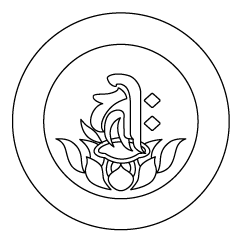|
||
 |
||

(C)2001 Japanese Architecture and Art Net Users System. No reproduction or republication without written permission.
掲載のテキスト・写真・イラストなど、全てのコンテンツの無断複製・転載を禁じます。
|
||||||
| bonjimon 梵字文 | ||||||
| KEY WORD : architecture / roofing tiles | ||||||
| Lit. Sanskrit motif. A Sanskrit character, bonji 梵字, that decorates pendants *gatou 瓦当; semi-cylindrical, convex eave-end tiles *nokimarugawara 軒丸瓦; or broad concave eave end tiles *nokihiragawara 軒平瓦. The character first appeared in the 11-12c. The bonjimon fills the entire surface of the pendant attached to the nokimarugawara. A late Heian period pendant unearthed at the Rokkakudou 六角堂 of Chouhouji 長法寺 in Kyoto has a diameter of 10cm. A damaged pendant that was once attached to a nokimarugawara excavated at Shitennouji 四天王寺 in Osaka dates between the end of the 11c and late 12c and has a diameter of 14cm. The rim was probably plain. The Sanskrit character is in the center but instead of filling the entire field, it is enclosed by a fluted border composed of stylized stamen which in turn is surrounded by an eight double petaled lotus motif called *fukuben rengemon 複弁蓮華文. This is said to be a unique treatment. The use of Sanskrit characters on eave end tiles *nokigawara 軒瓦, relates to the introduction of the Esoteric Buddhist sects of Shingon 真言 and Tendai 天台, which were brought to Japan from China by *Kuukai 空海 (774-835) and Saichou 最澄 (767-822). | ||||||
| |
||||||
 |
||||||
| REFERENCES: | ||||||
| EXTERNAL LINKS: | ||||||
| NOTES: | ||||||
(C)2001 Japanese Architecture and Art Net Users System. No reproduction or republication without written permission. 掲載のテキスト・写真・イラストなど、全てのコンテンツの無断複製・転載を禁じます。 |
||||||